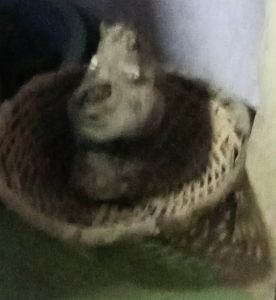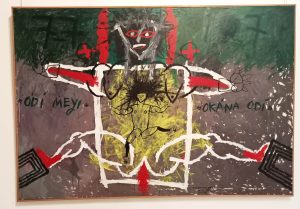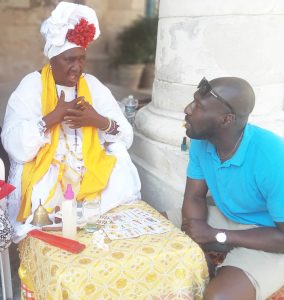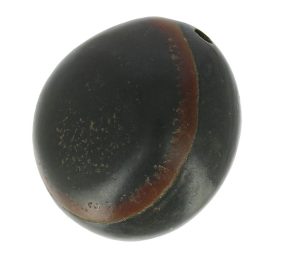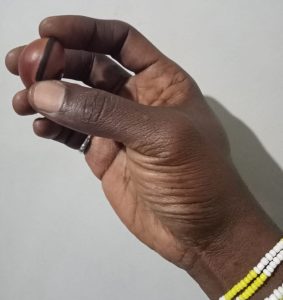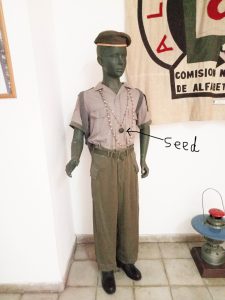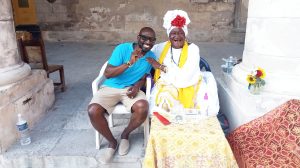ESU BY THE CUBAN DOOR
by Dalian Adofo
There he was, right at the doorway, visible to all who walked by. Seated comfortably in his clay pot with cowries for eyes that shone bright in the dark alleyway of central Havana. Mesmerised at this unexpected sight I moved closer to take a picture and was startled by a dog that ran from the interior of the house to the door, creating a noisy ruckus that led to the occupant of the house to also start shuffling towards the door.
I quickly walked on and chuckled to myself, perhaps Ogun wasn’t happy his initiate was going around trying to take a picture of private sacred objects, even though it was visible through the open iron grille covering the open front door. Hence the blurry image below, the only picture I had the time to take before having to engage in an uncomfortable conversation with the owner.
It had been 15 years since I last visited this remarkable island in the Caribbean, but the nature of the unjust US economic blockade is that hardly anything looks different. They are prevented from importing essential goods and services and as such infrastructure development is hardly ever on a grand or large scale. It looks trapped in time, yet the continuing structural decay is also an ever-present silent witness to an injustice that America continues to perpetuate with impunity because no other country dares to stand against it, even the United Nations General Assembly, where motions against it have been presented for 30 years but remain ignored.
The last time I was in Cuba I was a rather young idealistic graduate straight off an undergraduate degree and you can read more about those experiences here.
This time I was part of a delegation from the UK’s National Education Union’s International Solidarity section’s solidarity campaign for Cuba, (https://cuba-solidarity.org.uk/), whom have been lobbying for decades against the blockade.
It provided the opportunity to also experience Cuban society from an institutional level rather than as a visitor. The one thing I noticed to have changed tremendously was the prominence of African Spirituality in just about every space visited. Interestingly, I also did see my first Muslims in central Havana on the same day I chanced up my serendipitous ‘street divination’ whilst on a city tour.
In nearly every establishment, there was a coconut reserved in a corner somewhere for Eleggua, often with fruit, sometimes money both in coins and notes and sometimes a cigar. More people were now wearing ilekes (necklaces) and wearing various ilde/iddés (bracelets) to signify their affiliations with the various African Orishas. The most auspicious display I would witness were the entrails of an animal, likely a goat or sheep, placed outside the doorway of a bank, some-one getting their money up! I smiled at the sight, delighted at the degree of African cultural retention so alive and thriving there.
The most interesting dynamic of Cuba’s unique syncretism of African Spirituality and Roman Catholicism was at a casa in downtown Havana, where underneath a huge painting of Jesus and his disciples at the last supper, complete with flowing blonde hair, was a figure for Esu, playing his drum with cigar and money offering plate – clearly no religious conflict for the owner to celebrate both her traditions.
Such is how the Cuban mind has come to fuse the history and cultures of its resident cultures and people into a system where all is respected and represented. Even as the official stance is a country built on the socialist concept of ‘Emulcíon Socialista’, this article will peel further to highlight how akin it is to the African sacred concept of UBUNTU – alike in its directives. And then again, many scholars past and present (e.g Dr Clarke, Nkrumah etc) have frequently highlighted this overlap already- ‘African communality’ with the Western concept of socialism as derived off Karl Marx et al.
On the second day we were in downtown Havana after visiting the Belle Artes Museum, where various artworks again reinforced the African heritage, from the works of Wilfredo Lamb to more contemporary works such as Muñecas al Ebbo,1993 by Santiago Rodríguez Olázabal (below).
As we entered the square with Havana Cathedral, Catedral de San Cristóbal, an edifice half built by Jesuit priests and later completed by the Catholics, I noticed an elderly African woman, cigar in mouth, sat in the corner in front of her table with a bell and some cards. Her image is famous with visitors to Cuba as many take pictures with her posing with cigars as a visual souvenir of their trip but the items I noticed made me think she was also a woman of the ‘medicine’.
So, I bid my time and took the expected tourist picture but then I pointed to her cards, my IFA ilde/iddé and her bracelets and gestured my intent to have a reading. She immediately understood and gestured for me to sit down, sprayed some of her Florida Water on my hands and head and let me shuffle the cards and take out the first 12 cards. I had one of my colleagues translate her first few utterances but as we were on a schedule, we could not stay to hear its end but what I heard was enough for me to know the synchronicity of this divine moment.
Some of my colleagues, understandably, were not altogether comfortable as in their eyes I was being fanciful or even ‘superstitious’. I had ‘wasted money’ on a fruitless moment it seemed, until my colleague who translated started informing them of the personal details the medicine woman had revealed about me that most of them didn’t even know. I was even shocked myself; she knew how many children I had, down to my transitioned Ancestors and who had done what and when.
I was in awe as always, as to how spirit is ever present and even as we did not hear the full reading, she gave me a present that allowed me to gain full clarity of the entire message later. She gave me a large black seed used in Santeria for spiritual purposes (Zamora Seeds; Dioclea reflexa) which I recognised instantly as we have a similar seed in Ghana and across pretty much West Africa in spiritual work as well.
What was so interesting was that pretty much a year ago I visited Boti Falls with the family, as part of celebrating 11 years since the release of our first documentary Ancestral Voices: Esoteric African Knowledge(2011). This sacred waterfall of the Akan was one of the core locations we filmed at and so our second visit was to say thank you and when we arrived, Boti also gave us presents and messages in return. One of the symbols we found that day was the same seed I was given in Havana although yet to turn fully black. On returning to London and reading my journal entry of the Boti experience the year before, the message was further contextualised. Spirit works!
The next place I would see the seed was in the most intriguing place which further solidified the extent of the African heritage in Cuba. We visited the Literacy Museum to learn about the renown programme Fidel Castro used to transform the society into the only one with a 98% literacy rate, even as American attempted invasions and blockades took its toll. The programme involved sending individuals all over the country to teach all ages and groups, particularly those in the mountains normally separate from mainstream society. The necklace they wore as part of their uniform, all bore the same seed and even as I have asked my Cuban friends to investigate for me why this ‘ileke’ was used, I am content that the answer is self-evident.
Over the years I have read bits of information (yet to be unverified in any concrete form) about Castro himself being an initiate of Santeria and have seen in some of the historical video footage of memorials held during the revolution to celebrate martyred comrades with candle-light vigils etc, also had an African ceremonial feel even as the images reflected the Catholic cannon so I could never be too sure. Now however, I am very sure.
Even as we were there, they celebrated the day to mark the deaths of Che and Camilo Cienfuegos on the 28th of October, an annual event that involves school children throwing flowers into the ocean along the Malecon in Havana to venerate their memories and celebrate their life. So yes, I’m certain of the African hand now even more.
What also has been most illuminating on this trip has been the opportunity to learn about the social glue holding Cuba together termed ‘Emulacion Socialista’ (Social emulation) and how aligned it is with the African concept of Ubuntu. What Emulacion Socialista aims for, and Cuba is evidencing, is that by encouraging healthy competition and emulation of best practice between individuals and organisations for the common good, it enhances social cohesion. Through public recognition of exemplary efforts and behaviours, it encourages its citizens to see value in one another’s efforts and grow a supportive community framework for building each other up. Remember, Ubuntu simply whispers ‘I am because WE are’ – our modern-day adage is ‘No man/woman is an island’.
The experience has solidified what before I may have largely assumed. It is a clarity I am grateful to have had and one shared in the spirit of awakening our consciousness regarding our duty of care to each other as human beings. What Cuba is showing is how a principle can work in practice, even as it also has to defend against the burden of America’s blockade.
Its efforts to ensure a society free of racism, classism, gender inequality and the myriad of social ills that affect all societies and deepens inequalities is most notable, even as Cubans themselves acknowledge its an ongoing effort in order to maintain social cohesion and individual and community development. There is much that can be learnt from them and do check this link to support the efforts of the solidarity campaign which campaigns to raise funds and send over essential food, medical and education supplies to Cuba https://vivaeducacion.org.uk/
May the wisdom of the Ancestors continue to guide us forward in creating a world we truly deserve.
AmenRA.
Ase!
Written by Dalian Adofo
Ancestral Voices Co-founder


